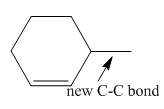
Concept explainers
(a)
Interpretation: Product of the given coupling reaction is to be predicted.
Concept introduction: Organocuprate reagents
Answer to Problem 26.1P
The product of the given coupling reaction is octane as shown below.

Explanation of Solution
Species containing copper-carbon bonds are known as organocuprate reagents. These reagents act as nucleophille and react with organic halides to form coupling products that contains new

Figure 1
Product formed from the coupling reaction is shown in Figure 1.
(b)
Interpretation: Product of the coupling reaction is to be predicted.
Concept introduction: Organocuprate reagents
Only one alkyl groupof the organocuprate reagent is transferred to form the product, while the other becomes part of reaction’s by-product.
Answer to Problem 26.1P
The product of the coupling reaction is

Explanation of Solution
Species containing copper-carbon bonds are known as organocuprate reagents. These reagents act as nucleophille and react with organic halides to form coupling products that contains new

Figure 2
Product formed from the coupling reaction is shown in Figure 2.
(c)
Interpretation: Product of the coupling reaction is to be predicted.
Concept introduction: Organocuprate reagents
Only one alkyl groupof the organocuprate reagent is transferred to form the product, while the other becomes part of reaction’s by-product.
Answer to Problem 26.1P
The product of the coupling reaction is

Explanation of Solution
Species containing copper-carbon bonds are known as organocuprate reagents. These reagents acting as nucleophille and react with organic halides to form coupling products that contains new

Figure 3
Product formed from the coupling reaction is shown in Figure 3.
(d)
Interpretation: Product of the coupling reaction is to be predicted.
Concept introduction: Organocuprate reagents
Only one alkyl groupof the organocuprate reagent is transferred to form the product, while the other becomes part of reaction’s by-product.
Answer to Problem 26.1P
The product of the coupling reaction is

Explanation of Solution
Species containing copper-carbon bonds are known as organocuprate reagents. These reagents act as nucleophille and react with organic halides to form coupling products that contains new

Figure 4
Product formed from the coupling reaction is shown in Figure 4.
Want to see more full solutions like this?
Chapter 26 Solutions
Organic Chemistry
 Organic Chemistry: A Guided InquiryChemistryISBN:9780618974122Author:Andrei StraumanisPublisher:Cengage Learning
Organic Chemistry: A Guided InquiryChemistryISBN:9780618974122Author:Andrei StraumanisPublisher:Cengage Learning EBK A SMALL SCALE APPROACH TO ORGANIC LChemistryISBN:9781305446021Author:LampmanPublisher:CENGAGE LEARNING - CONSIGNMENT
EBK A SMALL SCALE APPROACH TO ORGANIC LChemistryISBN:9781305446021Author:LampmanPublisher:CENGAGE LEARNING - CONSIGNMENT

